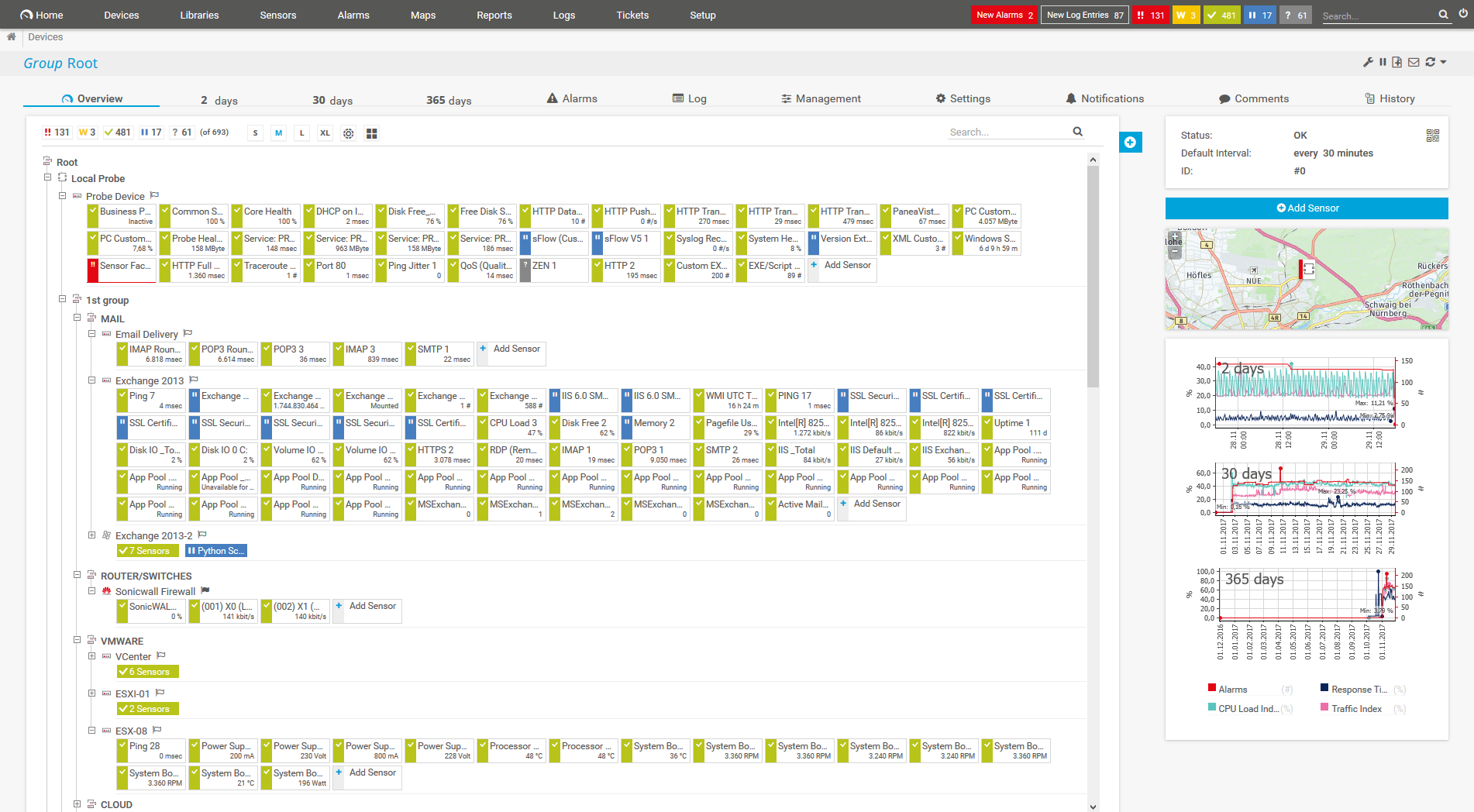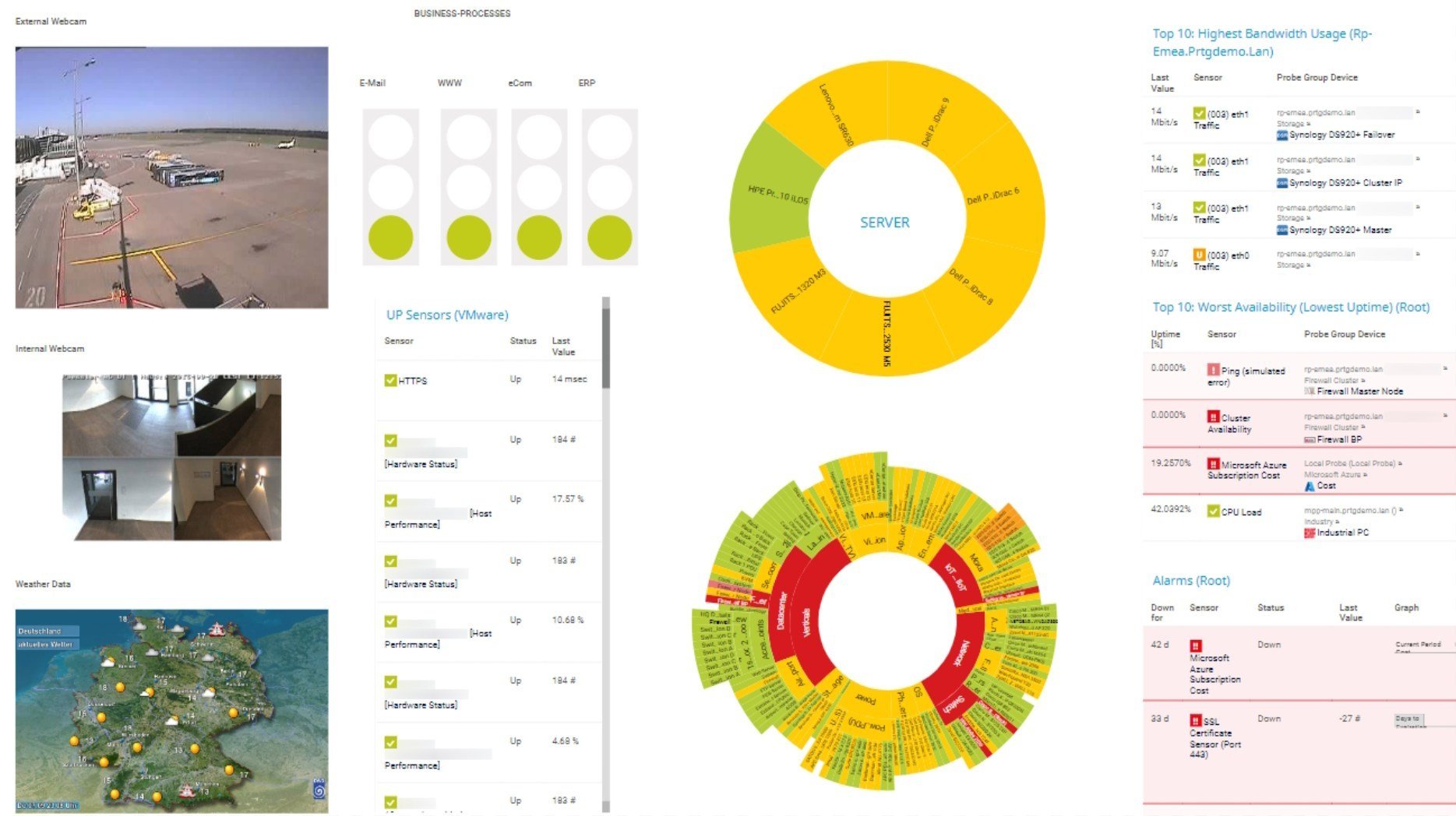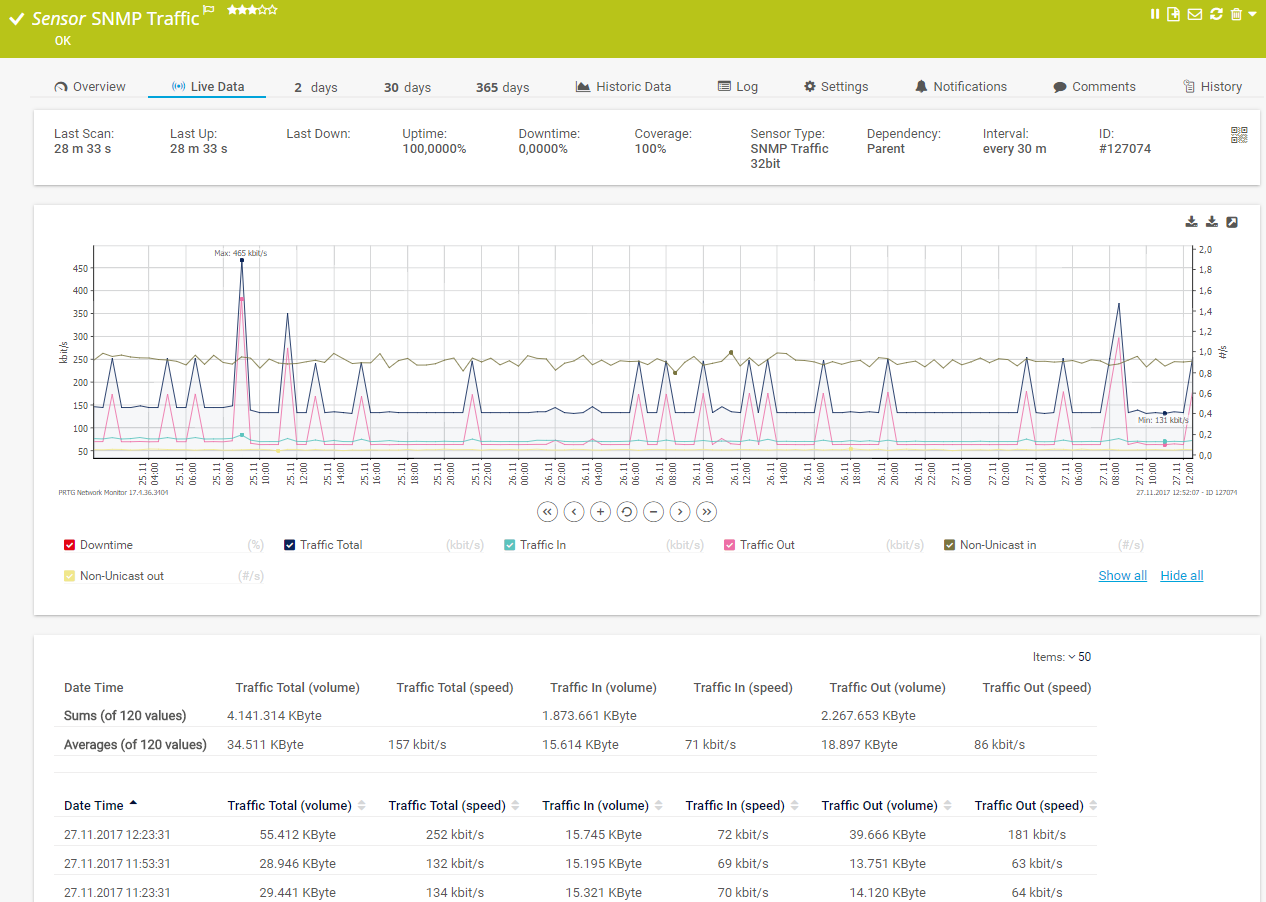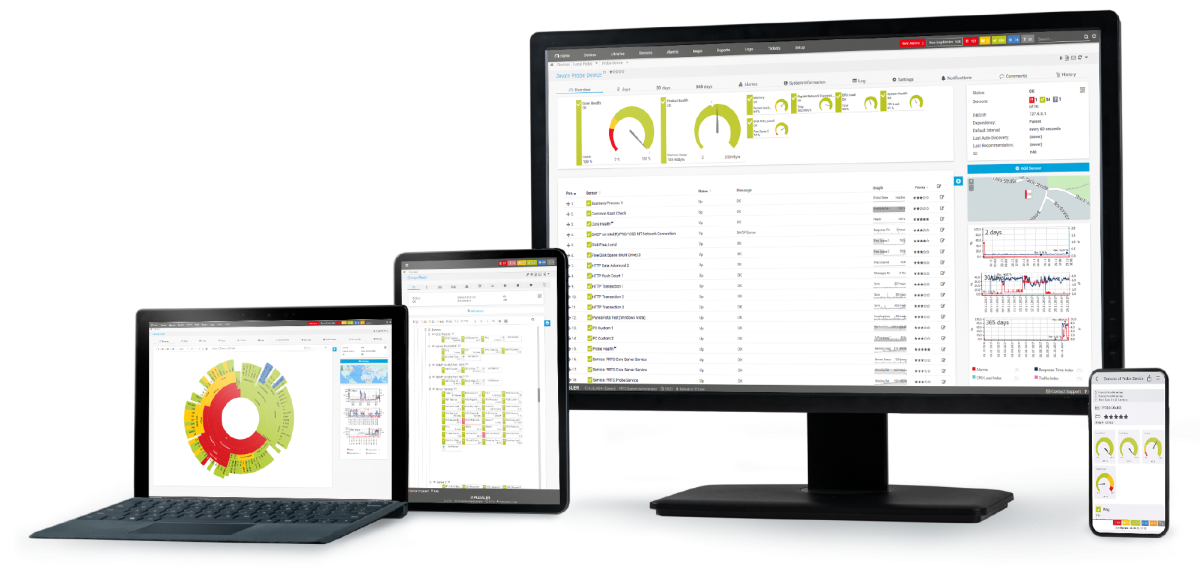Alertas personalizados e visualizações de dados permitem que você identifique e evite rapidamente a perda de pacotes, o congestionamento da rede, a latência, o jitter e outros problemas de conectividade.
Está tendo problemas com chamadas VoIP irregulares, velocidades de transferência lentas e falhas de conexão?
Obter mais largura de banda não é necessariamente a resposta. A forma como você está usando a largura de banda da rede disponível é igualmente importante se você quiser que sua rede Wi-Fi funcione sem problemas.
Com o PRTG da Paessler, você pode ver exatamente quais componentes de hardware e aplicativos de software em sua rede sem fio são os que mais consomem largura de banda em qualquer momento. Isso o ajudará a eliminar rapidamente os gargalos, gerenciar a utilização da largura de banda e distribuir seus recursos de forma mais eficaz.
Em vez de gastar mais dinheiro para obter ainda mais largura de banda, aproveite ao máximo os recursos que você já tem.
Ninguém gosta de gastar várias horas ou mesmo dias com a configuração de seu novo ambiente de monitoramento. Com o PRTG, você o colocará em funcionamento em minutos, com o mínimo de ajustes (ou de arrancamento de cabelos).
Escolha seu intervalo de endereços IPS preferido e a descoberta automática adicionará todos os dispositivos e aplicativos nesse intervalo, atribuirá os sensores apropriados e começará a rastrear o uso do WiFi. É isso aí.
O que acha da ideia de ter uma imagem completa do uso da largura de banda da sua rede na ponta dos dedos? Os sensores pré-configurados e prontos para uso do PRTG monitoram cada aplicativo, dispositivo e processo em sua rede sem fio.
Identifique exatamente para onde o tráfego da sua rede está indo, quais componentes estão com baixo desempenho como resultado e para onde você deve direcionar sua atenção na busca pelo culpado.
Gerenciar a largura de banda da sua rede é fácil... quando você tem os dados certos e usa as melhores ferramentas de monitoramento de largura de banda. Levante a cortina para o PRTG: ele rastreia o uso em toda a sua infraestrutura de TI em tempo real, permitindo que você faça ajustes em tempo real.
Além disso, você receberá alertas automáticos no momento em que a sua rede estiver em risco de exceder a capacidade, para que você possa começar a solucionar os problemas imediatamente.
Identifique padrões e tendências e tome decisões mais bem informadas sobre a capacidade de sua rede. Com o passar do tempo, o monitoramento da largura de banda WiFi com o PRTG cria dados históricos, o que lhe dá uma visão melhor dos picos de uso e dos problemas de largura de banda.
Dessa forma, você pode planejar com antecedência mais facilmente e fazer uso mais eficiente de seus recursos.
Diagnostique problemas de rede rastreando continuamente o desempenho de sua rede sem fio. Mostre a integridade do roteador, a taxa de transferência, a qualidade da conexão e outras métricas importantes em tempo real. Visualize os dados de monitoramento em gráficos e painéis claros para identificar problemas mais facilmente. Obtenha a Visão Geral de que você precisa para solucionar todos os tipos de problemas de largura de banda de WiFi.

Visualização em árvore de dispositivos da configuração completa de monitoramento

Painel PRTG personalizado para manter um olho em toda a infraestrutura de TI

Gráfico de dados de tráfego ao vivo no PRTG
O PRTG dá aos administradores de rede acesso a uma poderosa funcionalidade que lhe permite monitorar o uso da largura de banda e muito mais em toda a sua rede. Você será tão rápido quanto o roadrunner para encontrar a causa raiz dos gargalos da largura de banda. Rastreie todas as variáveis que possam afetar sua largura de banda, incluindo:
Os mais de 250 tipos de sensores pré-configurados do PRTG suportam o monitoramento via SNMP, WMI, contadores de desempenho do Windows, tecnologias de fluxo (incluindo NetFlow, sFlow, IPFIX e jFlow) SSH, HTTP e HTTPS e muito mais.
As notificações em tempo real significam uma solução de problemas mais rápida para que você possa agir antes que ocorram problemas mais sérios.
Configure o PRTG em minutos e use-o em praticamente qualquer dispositivo móvel.

“Excelente ferramenta para monitoramento detalhado. Alarmes e notificações funcionam muito bem. A adição de equipamentos é simples e a configuração inicial do servidor é bem fácil. ...sinta-se tranquilo em comprá-lo se você pretende monitorar um grande cenário de rede.”
Em parceria com fornecedores de TI inovadores, a Paessler libera sinergias para criar benefícios novos e adicionais para os clientes associados.
A integração dos resultados de monitoramento do PRTG aos mapas do NetBrain constitui a base para a automação da rede.
A TI que funciona constitui uma base essencial para o sucesso de uma empresa. A disponibilidade e a segurança devem ser definidas para a respectiva finalidade e monitoradas de perto, tanto pela OT quanto pela TI.
Com o ScriptRunner, a Paessler integra uma poderosa plataforma de automação de eventos ao PRTG Network Monitor.
Alertas personalizados e visualizações de dados permitem que você identifique e evite rapidamente a perda de pacotes, o congestionamento da rede, a latência, o jitter e outros problemas de conectividade.
Software de monitoramento de rede – Versão 25.3.110.1313 (August 27, 2025)
Download para Windows e versão baseada em nuvem do PRTG Hosted Monitor disponível
Inglês, alemão, espanhol, francês, português, holandês, russo, japonês e chinês simplificado
Dispositivos de rede, largura de banda, servidores, aplicativos, ambientes virtuais, sistemas remotos, IoT e muito mais
Escolha a assinatura do PRTG Network Monitor que é melhor para você
Nas redes corporativas, a largura de banda é a quantidade de dados que pode ser transferida entre dois pontos finais em um determinado período de tempo. A TI é normalmente medida em megabits por segundo (Mbps) ou, cada vez mais, em gigabits por segundo (Gbit/s).
Uma largura de banda maior significa que sua rede pode lidar com mais dados mais rapidamente, o que contribui para maior velocidade, estabilidade e confiabilidade. Quando a largura de banda é baixa, sua rede pode ficar mais lenta ou instável. A TI também pode não ser capaz de suportar todos os dispositivos de rede, aplicativos e outros componentes de que sua organização precisa para operar com eficiência.
Embora o monitoramento da largura de banda envolva o acompanhamento da quantidade total de dados transferidos por uma rede, o monitoramento do uso da largura de banda WiFi concentra-se especificamente nos dados que estão sendo transferidos por conexões sem fio. Ao contrário das conexões com fio, as redes sem fio podem ser afetadas por fatores adicionais, como intensidade do sinal, interferência ou o número de dispositivos conectados. O monitoramento da largura de banda Wi-Fi ajuda a identificar esses problemas específicos e fornece insights sobre o desempenho da sua rede sem fio e onde podem ou devem ser feitas melhorias para manter uma conectividade consistente e confiável.
O monitoramento da largura de banda de Wi-Fi significa rastrear a quantidade de dados que a sua rede sem fio está processando, enquanto o gerenciamento da largura de banda de Wi-Fi significa controlar e otimizar a largura de banda disponível para conexões sem fio. Pense da seguinte forma: se a sua rede Wi-Fi fosse uma rodovia, o monitoramento seria feito por câmeras de trânsito e o gerenciamento seria feito por medidas de fluxo de tráfego, como faixas de ônibus, limites de velocidade e semáforos.
Ambos são essenciais se você quiser gerenciar sua rede Wi-Fi de forma eficaz. O monitoramento da largura de banda de Wi-Fi mostra quanta largura de banda está sendo usada e quais dispositivos são os que mais falam. O gerenciamento da largura de banda Wi-Fi é o processo de avaliar os padrões de tráfego e se o uso da largura de banda atende às suas necessidades e, caso contrário, priorizar para onde ela deve ir.
O software de monitoramento de rede PRTG monitora todos os seus dispositivos Wi-Fi e pontos de acesso 24 horas por dia, permitindo que você veja exatamente quanta largura de banda um software, hardware ou outros componentes específicos estão usando a qualquer momento. Melhor ainda, ele o alerta se o consumo de largura de banda de Wi-Fi ultrapassar um limite predeterminado, para que você possa fazer ajustes imediatamente, antes que o desempenho da sua rede comece a ser prejudicado. Com a poderosa combinação de monitoramento do tráfego Wi-Fi em tempo real e análise avançada do tráfego Wi-Fi, você pode garantir que a sua rede sem fio permaneça otimizada e estável.
No PRTG, “sensores” são os elementos básicos de monitoramento. Um sensor geralmente monitora um valor medido na sua rede, por exemplo, o tráfego em uma porta de switch, a carga de CPU de um servidor ou o espaço livre em uma unidade de disco. Em média, você precisa de 5-10 sensores por dispositivo ou um sensor por porta de switch.
A Paessler realizou testes em mais de 600 departamentos de TI em todo o mundo para sintonizar seu software de monitoramento de rede mais próximo às necessidades dos administradores. O resultado da pesquisa: mais de 95% dos participantes recomendaria PRTG – ou já o fizeram.
Paessler PRTG é usado por empresas de todos os tamanhos. Os administradores adoram PRTG porque ele facilita muito o trabalho.
Largura de banda, servidores, ambientes virtuais, websites, serviços VoIP – PRTG monitora toda a sua rede.
As necessidades de monitoramento variam. Por isso deixamos você experimentar PRTG gratuitamente. Comece agora mesmo o seu período de testes.